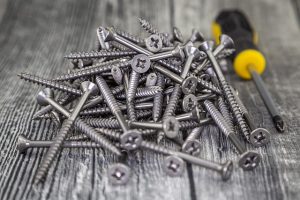
Not all screws have a mushroom-shaped head that protrudes out of the surface in which they are installed. Some screws have a shallower, countersunk head. Known as flat screws, they are commonly used in furniture, door frames and other fastening applications that require a smooth finish. Here’s everything you need to know about flat screws.
What Are Flat Screws?
Not to be confused with flat-head screws, flat screws are threaded fasteners with a countersunk head and a pointed tip. They have a conical head that’s flat on top and becomes narrower toward the shank. However, the precise angle of a flat screw’s head may vary. Some flat screws have an 82-degree angle, whereas others have a 90-degree angle. Regardless, all flat screws have a flat and conical.
With their flat and conical head, flat screws will sink into the surface of the objects in which they are installed. The head won’t protrude out of the surface. Instead, the head of a flat screw will sit flush with the object’s surface, resulting in a smooth and clean finish.
Flat Screws vs Flat-Head Screws: What’s the Difference?
Flat screws and flat-head screws aren’t the same. The term “flat screw” is used to describe any screw with a countersunk design. The term “flat-head screw,” on the other hand, is used to describe any screw with a flat-head or slotted drive recess.
All screws have a drive type. The drive type refers to the method or way in which a screw is driven into an object. Two of the most common drive types include Phillips head and flat head. Phillips head screws feature a cross-shaped recess, whereas flat-head screws feature a single horizontal slot.
Some flat screws are categorized as flat-head screws. If a flat screw has a horizontal slot for its drive type, it’s considered a flat-head screw. But you can find flat screws in a variety of drive types, such as Phillips, hex and square.
Benefits of Flat Screws
Flat screws offer several benefits that make them a popular choice, one of which is improved aesthetics. They don’t protrude out of the surfaces in which they are installed. Instead, flat screws sit flush while creating a smooth and clean appearance.
Another benefit of flat screws is improved safety. Exposed screw heads can pose a safety hazard. You may bump into an exposed screw head, resulting in bodily injury. While flat screws still have a head, the head remains flush so that injuries such as this are unlikely to occur.
